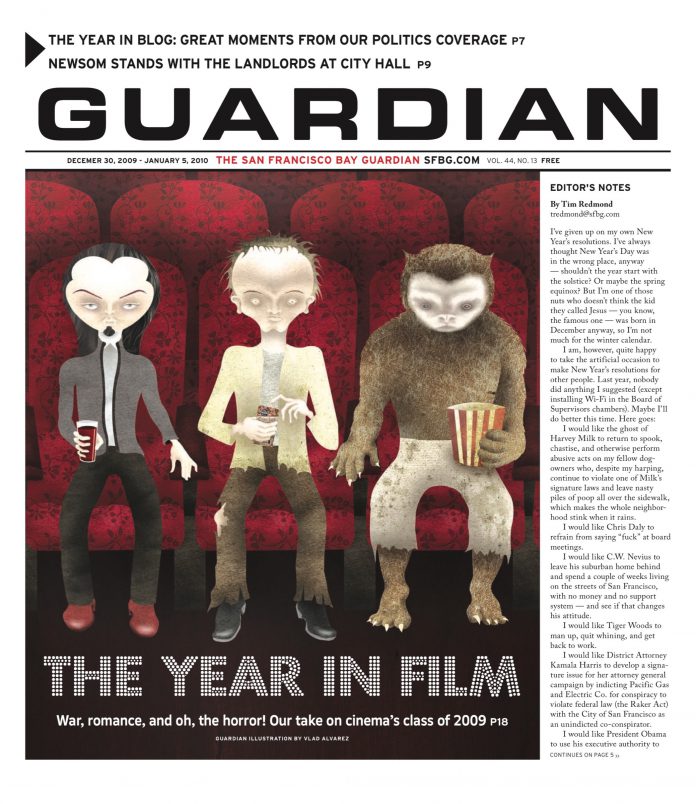YEAR IN FILM As the U.S. invasion of Afghanistan and Iraq nears its second decade, the question of its influence on modern American cinema has been redoubled by this year’s sampling of seminal combat films. Not only were Quentin Tarantino’s epical Inglourious Basterds and Kathryn Bigelow’s anti-epic The Hurt Locker two of the best releases of 2009, they represented a startling mutation in the zeitgeist’s popular narratives of geopolitics, absenting the requisite leitmotifs of nationalism, ethic, and archive. The disappearance of a moral imperative in Inglourious‘ Holocaust revenge parable and Locker‘s chronicle of an adrenaline junkie flummoxed numerous critics who admonished them for a dangerous aestheticization of war. Having accentuated the alternative fantasies and ecstasies of military violence, Tarantino and Bigelow committed the cardinal sin of privileging the inner experience of war over its ancillary politics, or, rather, made them one in the same.
Most of the putatively titled “war on terror” pictures, solidified as a genre in the aftermath of 9/11, fulfilled one of several bog-standard paradigms: the preening, ideological propaganda of Michael Moore (2004’s Fahrenheit 9/11) and Errol Morris (2003’s The Fog of War and 2008’s Standard Operating Procedure), with its leftist moralizing thinly camouflaged as real “documents” of war; the quasi-jingoist paeans to American imperialism in Black Hawk Down (2001) and We Were Soldiers (2002); and the grid-skipping, pan-global tourist thrillers Syriana (2005), The Kingdom (2007), and Body of Lies (2008). Regardless of their ideological positions, all of these war on terror films linked cinematic politics with moral engagement and the need for historicizing the truth of combat.
But Inglourious and Locker fail to follow any of the necessary formulae and are thereby excluded from the generic privilege of the modern war film. In its attempt at a sui generis retributive fantasy, Inglourious details a vicious gang of Jews who collect Nazi scalps and immolate Hitler in a third-act ejaculation as cartoonish as it is intertextual. Treading in a Pynchonian zone of alternative history, the film not only lampoons but seeks to rewrite the archive of the 20th century.
But Tarantino’s violence is not ballasted by any of the ruminative “what ifs” (what if the Holocaust could have been prevented? What if you could kill Hitler?) that have become the ethicist’s fundamental paradox. He obviates such moral concerns in favor of bloody spectacle and, in so doing, risks erasing the last, sacred vestiges of the Holocaust — namely, that it occurred. In Tarantino’s comic-book universe, fiction-making refuses to be caught in the crossfire between truth and engagement. The Slovenian philosopher Slavoj Žižek alludes to as much in his recent treatise on violence when he claims “the threat today is not passivity, but the pseudo-activity, the urge to ‘be active,’ to ‘participate.’ Those in power often prefer even a ‘critical’ participation, a dialogue, to silence. Sometimes, doing nothing is the most violent thing to do.” Such valuations are a disturbing reproach to the oft-repeated Holocaust maxim, “Never again.”
Similarly, Bigelow’s film pivots on the saga of American IED fatalities in Iraq, but celebrates as heroes morally dubious outlaws playing in the postmodern desert of the real. Locker‘s insidious epigram, “The rush of battle is a potent and often lethal addiction, for war is a drug” — lifted from Chris Hedges’ War is a Force That Gives Us Meaning — sums up a picture that is as much about the sensory pleasures of combat as its horrific ugliness. While Bigelow turns to the hard-boiled Americana of Samuel Fuller and Howard Hawks for her inspiration, she has translated them through what French cultural theorist Paul Virilio might term “dromocratic” consciousness, where traditional cinematic politics have disappeared and been replaced with a hyperreal “logistics of perception.”
The result is an apolitical pleasure dome of sensory overload; guns become canons, explosions appear as living sculpture, urban war zones are makeshift playgrounds. Like Inglourious Basterds, The Hurt Locker delights in its own ethical and political vacuum, generating fantasies of immolation without sourcing it as either a psychological grotesque (e.g. PTSD) or an ideological other (i.e. Nazis or Iraqis). When the IED experts finally reach the end of their tour, the tedious suburban lives that await them are a pathetic denouement. Is it possible, Bigelow seems to muse, that the real American dream lies on the battlefield and not the home front?

